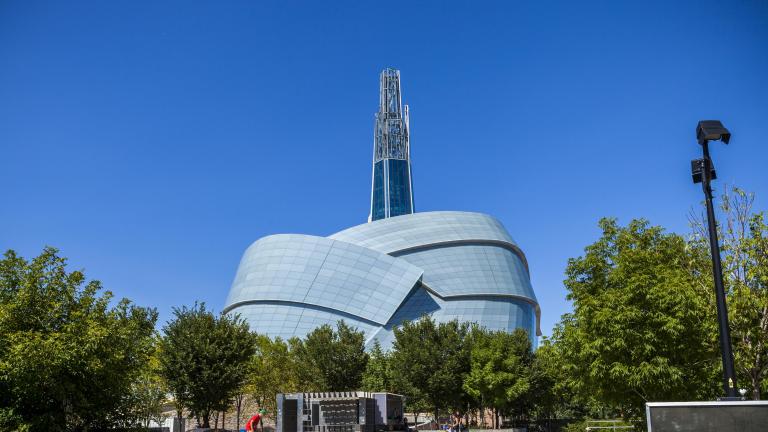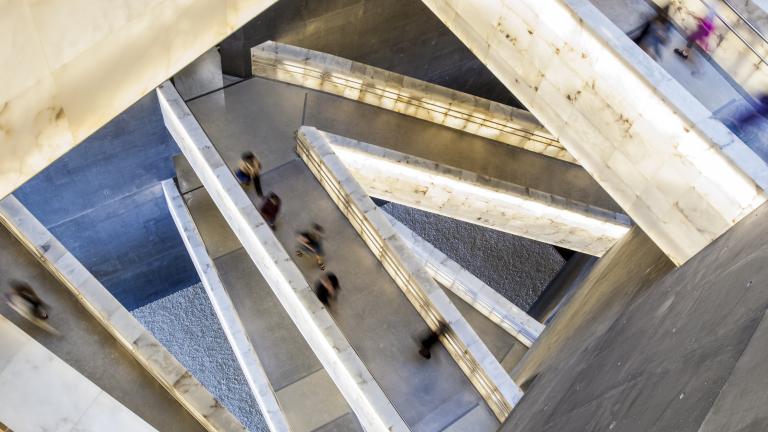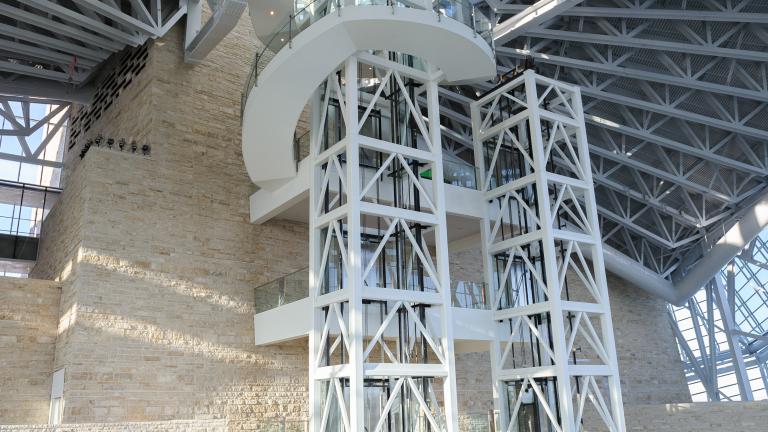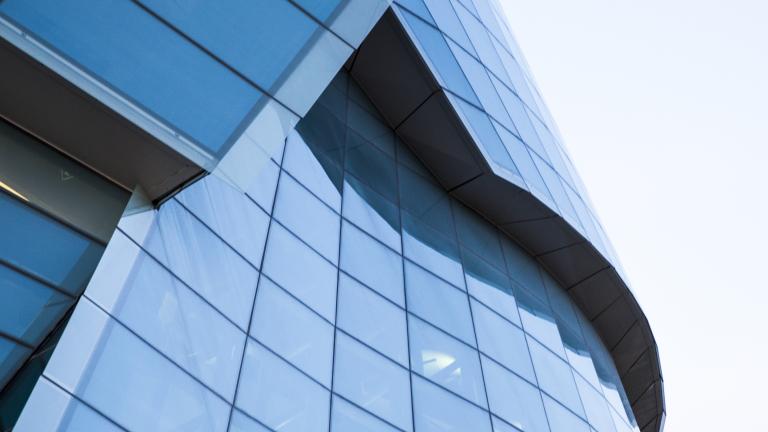The Building
A landmark built to celebrate human rights.
Located in downtown Winnipeg, the Canadian Museum for Human Rights stands as a beacon for the struggle to achieve equal human rights for all.

Photo: CMHR, Aaron Cohen
Page Navigation
The Museum is an innovative structure of curving lines and bold geometry. Many of the surfaces are irregular, with more than three‐quarters of the walls sloped at unusual angles. Antoine Predock's unconventional design required the latest building technologies, including 3D modelling.
Nearly
1 km
of alabaster‐clad ramps
The Glass Cloud
The building’s huge expanse of glass, called the Cloud, is made of 1,335 custom‐cut pieces of glass, with no two exactly alike. Construction of the Cloud took more than 5,600 square metres of scaffolding to install.
1,669
total pieces of custom glass in the Cloud and the Israel Asper Tower of Hope
5,400
tonnes of steel in the framework of the Cloud
State-Of-The-Art Tools
This building was the first large‐scale, complex project in Canada on which all teams used computer‐modelled design and construction. Contractors, suppliers and designers from around the world collaborated remotely using state‐of‐the‐art tools to ensure all teams had the most up‐to‐date information possible.
High Achievements
In 2014, Engineering News‐Record Magazine presented its Global Best Project (Cultural Category) award to the Museum. The Canadian Institute of Steel Construction (CISC) Ontario division also presented two design awards of excellence to the Museum, its builders and designers.
24,155
square metres of total building area
4,366
square metres of exhibit space
100‐
metre Israel Asper Tower of Hope
Green Design
Human rights and environmental responsibility are interconnected. If we protect the planet’s air, land, water and living things, we also support people’s rights, such as the right to live in health and safety, to earn a sustainable livelihood, and to maintain culture.
The Museum is committed to respecting and protecting the environment. This means minimizing the Museum’s impact on the natural world and people’s health, during the construction phase and as the building operates for years to come. We are also dedicated to education and dialogue about environmental stewardship.
More than
50%
of construction waste was recycled or salvaged.
The Museum harvests rainwater for air‐conditioning and toilet‐flushing systems.
More than
15%
of building materials (by cost) contained recycled content.
The windows in the Cloud, the building’s huge expanse of glass, contain a layer of argon gas for insulation.
More than
2,800
square metres of roof were seeded with prairie grasses and plants that are indigenous to Manitoba.
Building Green
Our team of architects and engineers designed the Museum to meet the high standard required for LEED (Leadership in Energy and Environmental Design) certification. LEED is an international green building certification program that measures the green quality and performance of a building’s materials. It also evaluates the construction process, the sustainability of the site, and the way the building functions – for example, its air quality and energy efficiency.
Through our green building features, we have achieved LEED Silver certification from the Canada Green Building Council.
A Sustainable Site
The Museum's grounds support vegetation and wildlife, while inside staff support recycling, composting and green commuting.
- More than 50 percent of construction waste was recycled or salvaged.
- The Museum features three green roofs. More than 2,800 square metres of roof were seeded with prairie grasses and plants that are indigenous to Manitoba, such as buffalograss and purple prairie clover. These perennials don’t need watering or fertilizer. Green roofs have many benefits, such as improving outdoor air quality, providing habitat for birds, and insulating the building from heat and cold.
- The building’s grounds are landscaped to create a drought‐tolerant prairie ecosystem. This makes the site the largest tract of native vegetation in an urban setting in Western Canada.
- The Museum has a comprehensive in‐house program to recycle glass, cans, paper, cardboard and scrap metal. It has a composting (organic waste recycling) program for its commercial kitchen and banquet operations, as well as its administration areas.
- The Museum has a phosphorus management program in relation to cleaning activities to minimize the amount of phosphate entering into waterways.
- To encourage staff to be green commuters, the Museum provides a bicycle lockup, showers and change facilities for employees who cycle to work. It also participates in a Winnipeg Transit program that provides subsidized bus passes for staff members who use transit.
Water Efficiency
The Museum has strategies to conserve water outside and inside the building.
- The Museum harvests rainwater. An underground cistern stores rainwater from roof run‐off for use in the air‐conditioning and toilet‐flushing systems. The goal for toilet flushing is to reduce water use by 50 percent, versus standard systems.
- Ultra‐low‐flow plumbing fixtures and waterless urinals in washrooms minimize water use. These are targeted to reduce water use by about 30 percent, compared to standard fixtures.
- The Museum’s green roofs and grounds require no irrigation.
- An innovative approach to stormwater prevents collected rainwater from being released directly into the Red River. Instead, stormwater accumulates in a cistern for use in the building, or in an overflow pond on the grounds, where it can be absorbed as groundwater or evaporate.
Energy Efficiency
We've implemented several systems to save energy in the operation of our building.
- High‐efficiency condensing boilers heat the building. These boilers recover energy from flue gasses that would ordinarily be wasted.
- The air‐conditioning system uses chillers that are up to 15 percent more efficient than standard chillers. These machines are highly efficient under part‐load conditions, which can occur as the number of people in the Museum varies throughout the day.
- The main air‐handling unit uses a heat‐recovery (enthalpy) wheel. It extracts energy from the building’s exhaust air, using it to pre‐heat incoming fresh air in winter or pre‐cool it in summer. In winter, the target for the wheel is to provide about 2.5 million BTU of heat per hour.
- Variable frequency drives (VFDs) are used on most large electrical motors in the Museum’s heating and cooling systems. They allow the equipment to turn on gradually and modulate based on the building’s requirements, reducing power usage compared to conventional motors.
- In office areas, space temperatures are set by a centralized system, helping to maximize energy efficiency.
- The windows in the Cloud, the building’s huge expanse of glass, contain a layer of argon gas for insulation. They are also made with a “frit” or dot pattern to reduce indoor solar heat and glare.
- Natural light from the Cloud reduces the need for artificial light. LED and high‐efficiency lighting is installed throughout the building.
- Occupancy sensors turn lights off when spaces are unoccupied.
Materials Selection
Careful selection of building materials is another way to support the environment.
- More than 15 percent of building materials (by cost) contained recycled content. Materials with recycled content included concrete, rebar, structural steel, drywall and furniture.
- Many materials, such as concrete and Tyndall stone, were sourced from the nearby region. This reduced the environmental impact of transporting them.
- To minimize the building’s effect on the ozone layer, no CFCs or HCFCs (ozone‐depleting substances) are used in the cooling system. No ozone‐depleting halons are used in fire‐suppression equipment.
Indoor Environmental Quality
The Museum aims to provide an indoor environment that supports a positive visitor and staff experience.
- All carpets, adhesives, sealants, paints and coatings were chosen to be low‐VOC‐emitting. This means they give off minimal volatile organic compounds (VOCs). The building was “flushed” before opening to further minimize any off‐gassing.
- Furniture in the Museum is GREENGUARD certified. This means it has met some of the world's most rigorous standards for low emissions of VOCs.
- An air‐quality monitoring system uses sensors to detect how much carbon dioxide is in the building. The system gauges when the vents need to add quantities of fresh outdoor air. This meets the needs of staff and visitors for fresh air and minimizes the possibility of wasting heating or cooling energy on more fresh air than is necessary.
- The Museum maintains a Green Housekeeping program that uses Green Seal‐certified cleaning products. No corrosive or environmentally harmful products are used. Cleaning staff are trained in green housekeeping.
Awards and Accolades
The Museum has won numerous awards and honours, including for excellence in building design and innovation in construction.
Architect's Vision
Drawing on stories of our struggle for human rights, renowned architect Antoine Predock takes visitors on an upward journey, leading them from darkness to light.




